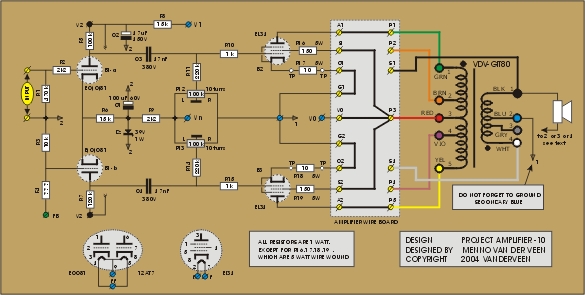I do have good reasons to start with amplifier 10 and not with amplifier 1. Everyone knows the old fashioned push pull pentode amplifier and therefore it is a good starting point. How to wire the wire boards is drawn in the standard form, which you can download by clicking ![]() here (form-10.pdf).The complete schematics of amplifier 10 is shown below. The high voltage supplies Vht1 and Vht2 are in parallel, together delivering a 370 V. Click the circuit diagram for full page view.
here (form-10.pdf).The complete schematics of amplifier 10 is shown below. The high voltage supplies Vht1 and Vht2 are in parallel, together delivering a 370 V. Click the circuit diagram for full page view.
I think it is wise to first explain the start-up procedure of this amp. All the amplifiers following will have the same procedure. Switch the standby “off” (no high voltage) and switch mains “on”. Check the glowing of the filaments of the vacuum tubes. Measure with your DC-voltmeter the voltage (with respect to ground) at the control grids of B2 and B3. You should read about –70 V. If that is not the case, turn P12 and P13 fully counter clockwise. Switch standby “on”. Be very careful, because now a high voltage of at least 370 V is present all around the amp. Measure with your DC-voltmeter over the cathode resistor R17 and over R18. Both readings should be almost 0 mV. Slowly turn P12 clockwise while watching the voltage over R17; stop when it reads 0.500 V. Repeat this with P13 until you measure 0.500 V over R18. In both power tubes the quiescent current now equals 50.0 mA. Also measure V0 = V1; its reading should be close to 370 V. The amplifier is ready for use.
The sound character of amplifier 10 is old-fashioned warm, dynamic and loud. This is easy listening with lots of space. But to be honest, the amp is better suited as a guitar amplifier because not all details can be clearly noticed. Also the mild overload of this amp makes it the best dark brown bluesy session amplifier.
The measurements contain many interesting details. For instance the wide –3dB frequency range. Also impressive is the full power lowest frequency of 14 Hz, where the large core of the OPT is at the edge of saturation. The damping factor is negligible; this is current drive and no voltage drive! This amp reacts very strong on the frequency dependant impedance of the loudspeaker. The warm sound character is understandable now. The input sensitivity for full power equals 810 mV. Most audio equipment easy delivers this voltage; this power amp is easy to drive. The open loop amplification factor will be very important for future discussions about local feedback. For now it is only a number.
Next time: amplifier 11

